Many things, especially well-known spices, wines, vinegars, sauces, etc., influence the taste of food. But vibrant flavor from botanicals? What comes to mind is the sometimes subtle flavors of herbs. How could delicate or restrained taste translate to vibrant flavor?
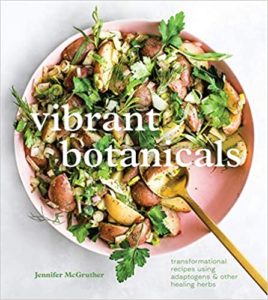 Vibrant Botanicals. Transformational Recipes Using Adaptogens & Other Healing Herbs. Jennifer McGruther, 2021. Published by Tenspeed Press. 233 pages, illustrations in color.
Vibrant Botanicals. Transformational Recipes Using Adaptogens & Other Healing Herbs. Jennifer McGruther, 2021. Published by Tenspeed Press. 233 pages, illustrations in color.
The cover of Vibrant Botanicals communicates a clear message. It says there are two aspects of the energetic flavor of herbs and spices. The cover illustration portrays an attractive dish of herbed potatoes, and the words seem to connote that taste can come alive with botanicals as well.
Inside, the 30+ botanicals for your pantry are infused into more than 100 recipes. These botanicals combine with favorite drinks and dishes, plus new ones that beg trying. Vibrant Botanicals upgrades the culinary adventure with herbal monographs and plenty of explanation about what makes an herb worthy of your plate.
Written for creative cooks, this herbal-cookbook may surprise you with fancier recipes like “Dark Chocolate Granola with Raspberries”, “Nettle Mint Infusion”, “Roasted Garlic and Onion Bisque with Sage and Thyme Broth” or even “Melon in Match-Honey Syrup”.
With “Slow-Roasted Saffron Chicken…” and five others featuring a variety of non-vegetarian selections, the cookbook is not limited to a single palate.
Some Vibrant Botanicals are Adaptogens
Perhaps because they’re considered to be adaptogenic, herbs like Eleuthero and Rhodiola are not yet widely known. Not yet a household term, the words “adpatogen” and recipes may be a bit surprising. Specifically vibrant, because their energy is balancing, adaptogens are well-suited to being eaten. In fact, some sources say that adaptogens have always been part of the diet of indigenous peoples in Asia.
Why should we eat them? Because adaptogens are considered to be gentle and the most like food of the herbs. Many of them are fruits or roots, leaves or flowers.
Eleuthero and Rhodiola are two adaptogens. So are Tulsi (Holy Basil) and Ashwaganda, ones you may have encountered already. Very plainly put, these herbs help our bodies to adapt to stress. They were discovered in modern times (as late as mid-20th century) to be helpful for athletic performance. Thus adaptogens have a specific affinity for strengthening the body and its functions so we can manage the stress of physical activity more easily.
Adaptogens are described more completely in Vibrant Botanicals. Or you could look into other sources for more information.
“Lean on your senses and intuition”
Jennifer McGruther, p.5.
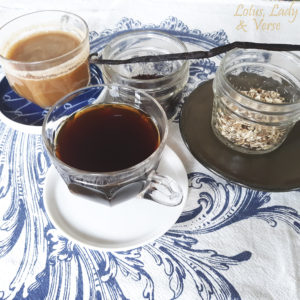 Do you often require coffee to wake up? The author encourages your exploration of ingredients in “Recipes to Start Your Day” with cacao, licorice, eleuthero, rhodiola, stinging nettle, tea, ginkgo, rosemary, sage, saffron, and turmeric. Then with “Herbs for Mental Clarity” for chocolate, fruit and teas, ghee, soup, herb-flavored nuts, garlicy white beans, saffron-rose cream, a main dish spiced with turmeric.
Do you often require coffee to wake up? The author encourages your exploration of ingredients in “Recipes to Start Your Day” with cacao, licorice, eleuthero, rhodiola, stinging nettle, tea, ginkgo, rosemary, sage, saffron, and turmeric. Then with “Herbs for Mental Clarity” for chocolate, fruit and teas, ghee, soup, herb-flavored nuts, garlicy white beans, saffron-rose cream, a main dish spiced with turmeric.
Vibrant Flavor from Kitchen Medicine
“Beyond flavor, you bring a distinct and ancient medicine to your meals… Cooking with herbs draws upon primal traditions and a time when both food and medicine were inextricably linked.” p.4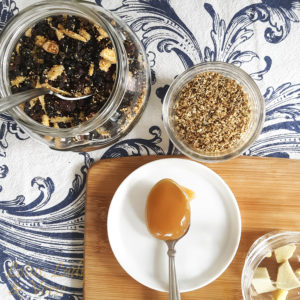 McGruther’s whole collection of herbs and spices for kitchen medicine are “Recipes to Start Your Day”, “Recipes to Support Immunity”, “Recipes to Support Digestion”, “Recipes to Lift Your Spirit”, and “Recipes for a Good Night’s Sleep”.
McGruther’s whole collection of herbs and spices for kitchen medicine are “Recipes to Start Your Day”, “Recipes to Support Immunity”, “Recipes to Support Digestion”, “Recipes to Lift Your Spirit”, and “Recipes for a Good Night’s Sleep”.
What I appreciate about Vibrant Botanicals is that cooking with kitchen medicine encourages a variety of preparation techniques. Not only can you make full-course dinners, but there are plenty of drink recipes and easier breakfast, snack recipes.
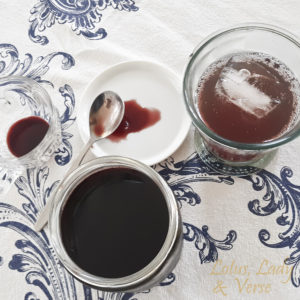 Try your hand at making an herbal infusion for immunity. For example, I made Elderberry Syrup from “Recipes to Support Immunity”.
Try your hand at making an herbal infusion for immunity. For example, I made Elderberry Syrup from “Recipes to Support Immunity”.
You can pour syrup (a tablespoon) into sparkling water for a refreshing way to drink your immune herbs. Or, ladle the syrup (a spoonful) over toast, into yogurt, etc.
In just an hour’s concentration, I managed to make 2 more of the recipes: a nourishing and liver-healthy latte, and a summer-cooling fruit punch. The latte’s rich taste wasn’t lost on a coffee-lover like myself! And the fruit punch—wow, how wonderful to drink a refreshing Hibiscus-Pineapple Punch with no added sugar!
Classic & Aromatic Vibrant Flavors
Vibrant herbs or botanicals are rich in taste and healthy properties. As a reader, you get a mini-lesson in kitchen medicine from the book’s botanical or herb profiles. You’ll come out of this experience the wiser for having paired health-giving herbs with familiar foods and recipes.
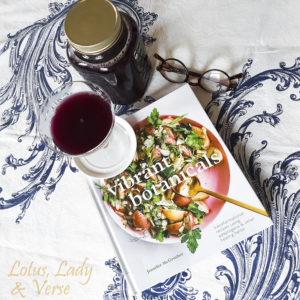
As powerfully rich and healing herbs, they elevate the cooking and sharing of food to a superior status, gourmet with high healing value. It’s you, the cook or diner who values aromatics and flavors in your home kitchen.
The Properties in Botanicals
McGruther’s botanicals are selected for nourishment, whether they have healing properties, and the sensations of taste and texture. The author advises cooking with dried or fresh herbs or spices rather than supplementing with capsules, etc. Herbal activity in seeds, leaves, bark, flowers, or roots is what McGruther is inviting us to experience, in our own kitchens!
Herbal Safety
It’s helpful to keep in mind the notes on Herbal Safety. The considerations involve pregnancy and conception, breastfeeding, and other matters. Herbs that are high in one component may trigger adverse reactions, given a condition or sensitivity. McGruther indicates that these herbs are generally safe, but taking large amounts over time may cause a reaction, if you are sensitive. The advice is to look at the chart in Vibrant Botanicals and discuss with your health care provider when you’re embarking on a new diet such as including these herbs in your meals.
Jennifer McGruther’s other books are : The Nourished Kitchen and Broth and Stock. Her website is nourishedkitchen.com
For more on this website concerning adaptogens, please see this post.
Notes on names and Adaptogens:
Ashwaganda has the scientific name Withania somnifera. Native to India, the Mediterranean and the Middle East, it’s also grown in home gardens in the U.S.
Eleuthero has the scientific name Eleutherococcus senticosus. Native to Russia, China, Korea and Japan, this herb is also known as Siberian Ginseng.
Licorice has the scientific name Glycyrrhiza glabra. Native to Europe and Asia, it’s also grown worldwide.
Rhodiola has the scientific name Rhodiola rosea and was discovered in the mountains of the Arctic.
Tulsi has the scientific name Ocimum tenuifolium, a beloved plant all over India and Southeast Asia.



